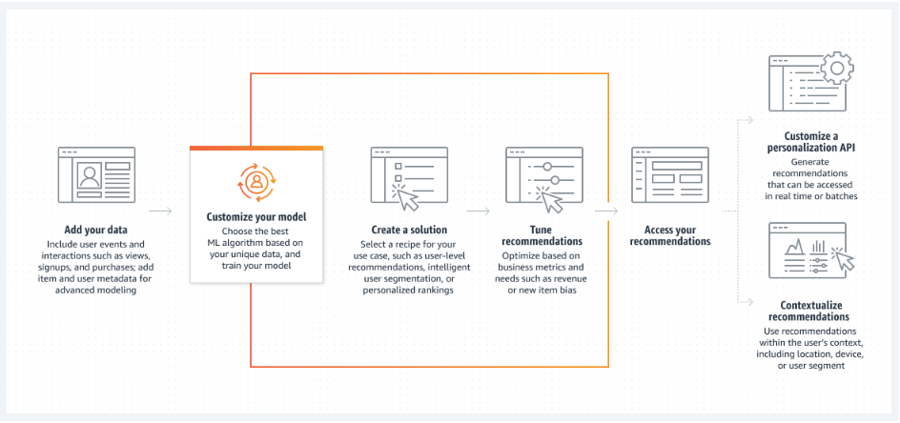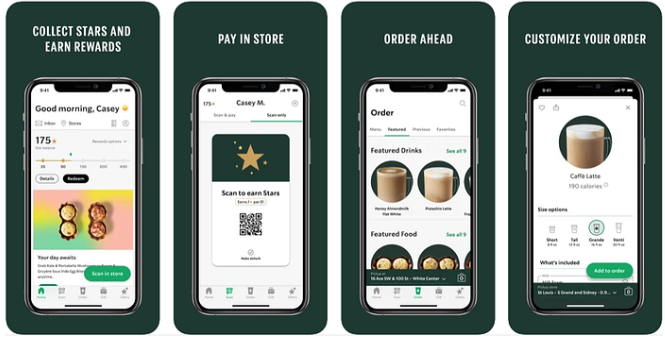Fierce competitors within the eCommerce market means retailers at all times want one thing new to seize the eye of their goal prospects. Nonetheless, AI is bridging the hole. This digital assistant can create extra related and fascinating procuring experiences for patrons.
It additionally proves useful in offering useful insights into buyer habits and preferences, boosting conversion charges, and serving related merchandise, content material, and promotions to customers.
Preserve studying to find how you should use AI to craft a customized procuring expertise on your prospects.
Understanding AI-Powered Personalization
In eCommerce, AI is a game-changer resulting from its potential to course of huge quantities of information and extract useful insights. You may’t deny its relevance in eCommerce for a number of causes:
- Knowledge Processing: Ecommerce generates huge quantities of information, from shopper habits to transaction histories. AI can effectively analyze this information to derive significant patterns and developments.
- Personalization: Machine studying in on-line retail tailors the procuring expertise for particular person prospects. In consequence, AI can present extra customized product suggestions and CTAs.
- Automation: AI can automate varied duties, from offering buyer help to optimizing pricing and stock. With this automation, you’ll be able to streamline your small business operations and enhance effectivity.
- Predictive Analytics: AI can predict future developments and buyer behaviors. Companies can put together for future calls for, optimize advertising and marketing methods, and make knowledgeable selections.
- Actual-Time Adaptation: AI operates in real-time to regulate content material and proposals as prospects work together with an app or web site. This ensures that the procuring expertise stays related and fascinating.
AI-powered product suggestions improve buyer loyalty and model engagement. You may even use AI to dynamically customise web site content material, banners, and promotions based mostly on buyer habits.
Ecommerce platforms gather huge quantities of information, together with buyer profiles, looking habits, buy historical past, and so on. AI algorithms course of this information to establish patterns and developments and create a deep understanding of buyer preferences and habits. Machine studying fashions make predictions and proposals to enhance accuracy.
AI operates in real-time whereas utilizing information from a buyer’s present session to personalize the procuring expertise. And don’t fear about information safety — AI methods will be designed to deal with information securely and guarantee compliance with privateness laws.
1. AI-Pushed Product Suggestions
AI-driven product suggestions provide a spread of advantages to each companies and prospects, together with:
- Elevated Gross sales: Personalised product suggestions entice prospects to make extra purchases, which results in increased conversion charges and income. Clients like to purchase merchandise that align with their preferences.
- Enhanced Buyer Expertise: Clients at all times admire relevance and comfort. You may create a extra pleasurable procuring journey with tailor-made suggestions.
- Buyer Retention: When customers constantly discover what they need, they’re extra more likely to return for future purchases. This performs a significant function in boosting buyer loyalty and long-term engagement.
- Diminished Cart Abandonment: With related product ideas, you’ll be able to tackle buyer indecision, resulting in diminished cart abandonment charges. AI-driven suggestions information prospects by way of the shopping for course of.
- Cross-Promoting and Upselling: AI identifies alternatives to current associated merchandise or higher-value gadgets. In consequence, it could possibly improve common transaction worth and income.
Algorithms Behind Personalised Product Suggestions
The effectiveness of AI for on-line shops and eCommerce lies in its algorithms that analyze buyer information and habits. Listed below are the elemental algorithms used:
- Collaborative Filtering: This algorithm analyzes consumer habits and finds patterns of similarity between prospects. It recommends merchandise that customers with comparable preferences have proven curiosity in.
- Content material-Primarily based Filtering: These algorithms contemplate the attributes of merchandise and match them to a buyer’s historic preferences. If a buyer beforehand purchased a inexperienced gown, the algorithm would possibly advocate different inexperienced clothes gadgets.
- Matrix Factorization: These methods break down user-item interactions into latent components and make suggestions based mostly on underlying traits.
- Deep Studying: Neural networks, together with deep studying fashions, can course of complicated information and provide extremely correct suggestions. They excel at dealing with unstructured information reminiscent of pictures and textual content.
- Hybrid Strategies: Many methods use a mix of those algorithms to enhance suggestion accuracy. Hybrid strategies leverage the strengths of various algorithms to offer extra well-rounded ideas.
2. Content material Personalization with AI
For eCommerce enterprise progress, you need to tailor digital content material to particular person customers based mostly on their habits and preferences. Listed below are some methods for content material personalization with AI.
Customizing Content material for Particular person Consumers
Personalizing content material means creating a novel and related expertise for every shopper. Netflix makes use of AI to customise the content material displayed on its homepage for every consumer.

Supply: Netflix
To show content material, it analyzes your viewing historical past and preferences to advocate films and TV exhibits you’d seemingly take pleasure in. This results in longer viewing periods and elevated consumer satisfaction.
Leveraging Machine Studying for Content material Suggestions
Machine studying algorithms are the spine of content material personalization. They analyze consumer information to make real-time suggestions. For instance, Amazon employs machine studying to counsel merchandise based mostly on looking and buying historical past.

Supply: Amazon
For instance, Amazon will advocate digicam equipment when you’ve been looking DSLR cameras. This will increase the probabilities of cross-selling and upselling.
Affect of Personalised Content material on Conversions
The impression of customized content material on conversions is critical.
For instance, Spotify makes use of AI to curate customized playlists for customers based mostly on their music preferences and listening habits.

Supply: Spotify
This could improve consumer engagement, longer time spent on the platform, and a better probability of upgrading to a premium subscription.
Sensible Methods for Implementing AI-Pushed Content material Personalization
To implement AI-driven product suggestions in your eCommerce platform, observe these steps:
- Gather Knowledge: Collect and retailer buyer information. You want buy historical past, looking habits, and demographic info.
- Choose an Algorithm: Choose an algorithm or mixture of algorithms that align with your small business objectives and information. Contemplate the complexity of your product catalog and the character of your buyer information.
- Integration: Combine the chosen algorithm(s) into your eCommerce platform. This will require technical experience or using third-party suggestion engines.
- Testing and Optimization: Constantly check and optimize your suggestion system. Monitor efficiency metrics, gather consumer suggestions, and make changes to enhance the accuracy of ideas.
- Actual-Time Suggestions: Present suggestions in real-time as customers work together along with your platform or web site.
- Privateness and Safety: Be sure that you deal with buyer information securely and in compliance with privateness laws. Buyer belief is crucial.
- Person Interface: Implement a user-friendly interface to current suggestions to prospects. Make it intuitive and visually interesting.
- A/B Testing: Conduct A/B checks to evaluate the impression of suggestions on consumer engagement and gross sales. Use the outcomes to fine-tune your suggestion engine.
- Multichannel Personalization: Lengthen personalization past your web site to e-mail advertising and marketing, cellular apps, and different touchpoints with prospects.
Utilizing AI for on-line retailer optimization can create a aggressive edge and hold prospects engaged and glad.
3. Tailor-made Buyer Journeys
To create tailor-made buyer journeys, you need to customise the experiences your prospects have at every level. Take note of each step, from the preliminary interplay to the ultimate buy.
Mapping Personalised Buyer Journeys
First, phase your prospects based mostly on their demographics, preferences, and behaviors. Determine the vital buyer personas you wish to goal with customized journeys.
Subsequent, map out the varied contact factors the place prospects work together along with your model, reminiscent of web site visits, social media, e-mail engagement, and so on.
Then, customise content material and messaging for every buyer phase and contact level. Use AI-driven suggestions and dynamic content material to make the client journey extra related.
Lastly, guarantee consistency in messaging and branding throughout all buyer touchpoints to offer a seamless expertise.
Predictive Analytics and AI-Powered Insights
You may also leverage predictive analytics and AI to realize insights into buyer habits and preferences.
Gather and analyze information on buyer interactions and transactions by way of varied channels, together with your web site, emails, social media accounts, and the contact center. Determine patterns and developments to anticipate buyer wants.
You must also predict future buyer habits based mostly on historic information, such because the likelihood of a purchase order. Use these predictions to supply tailor-made suggestions and content material.
AI may even decide the optimum timing for buyer interactions, reminiscent of sending emails or notifications based mostly on when a buyer is most definitely to interact.
Crafting Dynamic Procuring Experiences
Create dynamic procuring experiences that adapt to particular person preferences and behaviors. Observe these steps:
- Actual-Time Personalization: Implement real-time personalization to regulate content material and product suggestions as prospects browse your web site or app.
- Procuring Cart Optimization: Use AI to remind prospects of deserted procuring carts. Provide incentives or product suggestions to encourage them to finish their buy.
- Location-Primarily based Personalization: Use geolocation information to offer location-specific presents and proposals. It is going to improve the in-store or on-line procuring expertise.
KPIs for AI-Enhanced Buyer Journeys
To measure the success of AI-enhanced buyer journeys, observe key efficiency indicators (KPIs) reminiscent of:
- Conversion Fee: Calculate the variety of guests who take a desired motion, reminiscent of signing up for a publication or making a purchase order choice.
- Common Order Worth (AOV): Monitor the common quantity prospects spend throughout purchases, which may improve with customized suggestions and cross-selling.
- Buyer Retention: Observe how effectively your customized journeys retain prospects and encourage repeat purchases.
- Click on-By means of Fee (CTR): Assess the effectiveness of customized content material by measuring the speed prospects click on on beneficial merchandise or hyperlinks.
- Buyer Satisfaction: Collect buyer suggestions to gauge satisfaction with the customized experiences and adapt based mostly on their responses.
- Buyer Lifetime Worth (CLV): Calculate the worth a buyer brings to your small business over their whole relationship along with your model.
- Average Revenue Per User (ARPU): Consider the common income generated from particular person prospects, which will be optimized by way of tailor-made buyer journeys and customized choices.
- Cart Abandonment Fee: Monitor the speed prospects abandon their procuring carts and implement methods to cut back abandonment by way of personalization.
Success Story: Starbucks’s Personalised Presents and Suggestions
Starbucks’s cellular app tailors buyer journeys by offering customized presents, unique reductions, and order ideas based mostly on earlier buy historical past. The app makes use of predictive evaluation to anticipate buyer preferences and order patterns.

Supply: Apple App Store
It ensures sending well timed and related presents. Clients obtain real-time notifications about close by retailer promotions and customized drink suggestions. It enhances the in-store and cellular app expertise.
4. AI in Buyer Assist and Engagement
AI has reworked the best way companies work together with prospects and supply help. Right here is how AI is making a big impression on buyer help and engagement.
AI Chatbots Revolutionizing Buyer Interplay
AI-powered chatbots will be out there 24/7 to reply buyer inquiries and supply help. They use pure language processing to know and reply to buyer queries.
Chatbots can deal with routine requests, reminiscent of answering FAQs or monitoring orders. It offers human brokers extra time for complicated points.
For instance, IBM and Microsoft use AI chatbots to offer environment friendly and instant buyer help.
Personalised E-mail Advertising Campaigns
AI analyzes buyer information to create extremely customized e-mail advertising and marketing campaigns. It tailors content material, product suggestions, and timing based mostly on buyer habits and preferences. Personalization, in consequence, will increase e-mail open charges and conversions.
Amazon sends personalized product recommendations through e-mail, encouraging prospects to revisit the platform and buy.
Actual-Time Buyer Assist With AI
AI presents real-time help by way of reside chat or messaging apps, offering immediate solutions and help. It might deal with a number of inquiries concurrently, decreasing wait instances and enabling higher communication with prospects.
AI may even route complicated points to human brokers when vital, making certain a seamless buyer expertise.
For instance, Apple and Verizon use AI-driven chat for real-time buyer help.
Enhancing Buyer Loyalty By means of AI-Pushed Engagement
AI analyzes buyer information to know preferences, behaviors, and shopping for patterns. It helps companies provide customized rewards, reductions, and incentives to construct buyer loyalty.
AI can even ship reminders, product suggestions, and presents to interact prospects.
As mentioned beforehand, Starbucks makes use of its cellular app to supply rewards, customized reductions, and a seamless cellular order and pay expertise, enhancing buyer loyalty.
5. Overcoming Challenges and Privateness Considerations
It’s straightforward to beat challenges and tackle privateness issues by implementing AI, particularly within the context of personalization. Here is how organizations can navigate these points.
Balancing Personalization with Knowledge Privateness
In AI-driven methods, you need to stability personalization with information privateness. This implies respecting consumer privateness whereas offering tailor-made experiences.
Guarantee customers present express consent for information assortment and personalization. Clearly talk how you’ll use their information.
Use anonymization methods to guard consumer identities whereas delivering customized content material.
Addressing Widespread Challenges in AI Implementation
Among the most typical challenges confronted are the standard of information and integrations. You may tackle these simply:
- Knowledge High quality: Create a fact-checking system to make sure that AI-provided information/insights are correct, related, and up-to-date. Spend money on information cleaning and validation.
- Interoperability: Combine AI methods seamlessly with present and rising applied sciences and processes to keep away from disruptions.
Staying Compliant with Knowledge Safety Rules
AI should adhere to information safety laws, reminiscent of GDPR and CCPA. This may be carried out by practising:
- Knowledge Minimization: Gather solely the info vital for personalization and delete it when it is not wanted.
- Knowledge Portability: Enable customers to entry and transfer their information as laws require.
Constructing Belief with Clear AI Practices
To construct belief, your AI practices needs to be clear and comprehensible. When speaking along with your prospects about your use of AI, your messages needs to be:
- Straightforward to Perceive: Guarantee AI decision-making is explainable to customers, with clear causes for suggestions.
- Clear: Disclose using AI for personalization, detailing information utilization and sharing practices.
Future Tendencies in AI-Pushed eCommerce Personalization
AI-driven eCommerce personalization is evolving quickly, and a number of other future developments can form the panorama. Listed below are two key developments and their implications to be careful for.
Voice Commerce and Digital Assistants (VAs)
With the growing reputation of digital assistants like Amazon’s Alexa and Google Assistant, voice commerce is changing into a big development. You may count on to see the popularization of:
- Voice-Activated Procuring: AI will play a pivotal function in enabling voice-activated procuring, the place customers should buy and obtain suggestions by way of voice instructions.
- Conversational AI: Chatbots and digital assistants will turn into extra conversational and human-like. They are going to be able to understanding context and offering customized product suggestions. This makes the procuring expertise extra pure and handy.
- Personalised Voice Suggestions: AI will leverage consumer profiles and preferences to supply customized voice suggestions. It ensures that the merchandise steered align with particular person tastes and desires.
- Voice Search Optimization: Ecommerce companies will give attention to optimizing their content material for voice search as a result of extra customers use VAs to seek out services and products. AI will help in understanding voice queries and delivering related outcomes.
Augmented Actuality (AR) and AI-Powered Procuring
New applied sciences will proceed to remodel the eCommerce panorama. Alongside AI, manufacturers are more and more implementing augmented actuality into their procuring experiences. AI and AR will quickly collaborate to supply prospects immersive experiences like:
- AR-Enhanced Product Visualization: Consumers will use AR apps to visualise merchandise of their actual surroundings earlier than buying, from making an attempt on garments to seeing how furnishings suits of their properties.
- Personalised AR Suggestions: AI will analyze buyer preferences and counsel AR experiences that match their pursuits. For instance, if a buyer loves inside design, they may obtain AR-enhanced suggestions for furnishings procuring.
- AI-Pushed Digital Strive-Ons: AI will energy digital try-on experiences, the place prospects can see how clothes, equipment, or make-up look on themselves utilizing AR. These try-on simulations will likely be extremely customized.
- Actual-Time Procuring Help: AI will present real-time help throughout AR-enhanced procuring experiences. It might information prospects by way of product options and choices. Furthermore, it would provide customized ideas based mostly on what the consumer is viewing by way of AR.
Unleash AI’s Potential in eCommerce Personalization
AI-driven eCommerce personalization has quickly advanced during the last decade, revolutionizing how companies work together with prospects whereas growing consumer satisfaction. Firms ought to provide distinctive and tailor-made procuring experiences to seize new customers and guarantee model loyalty.
Embrace the way forward for on-line retail and keep forward of the competitors with AI-driven personalization.




